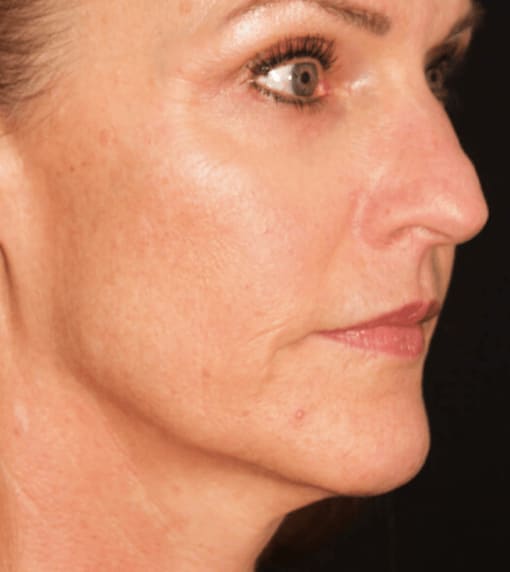
The Skinny
Jaw Surgery can be used to achieve the correct position of the upper jaw, lower jaw, or both. It is an oral surgery that can improve dentofacial deformities and thereby enhance the facial appearance and improve oral health. Although it is considered safe for good candidates, it is a serious surgical procedure that requires general anesthesia, a 3-4 day hospital stay, and typically takes up to 3 months to recover from.
This article explains some of the most common types of jaw surgery, the benefits associated with it, its safety, and the average cost. Jaw surgery before and after pictures, candidacy, preparation, procedure steps, and recovery are also reviewed.
AEDIT
Before & After Images by Provider






Before & After Images by Provider
Jaw Surgery (Orthognathic Surgery) Solutions
The Specifics
What is Jaw Surgery?
Jaw surgery is also called Orthognathic (or-thog-nath-ik) Surgery. Corrective jaw surgery is used to improve breathing problems and other functional problems that are common with a wide array of skeletal and dental irregularities.
This procedure is performed by a board-certified oral and maxillofacial surgeon (OMS). Its goal is to improve oral function by adjusting the positions of the jaws and teeth. It can be used to help patients with misalignment of the upper and lower teeth that causes:
A board certified maxillofacial surgeon can perform various orthognathic procedures that realign the teeth and jaw bones, thereby enhancing their function. While jaw surgery is recommended for correcting problems with chewing, talking, and other day-to-day functions, it commonly results in improvements to facial appearance. Orthognathic surgery is not an outpatient procedure. It requires staying in a hospital or surgical facility for 3-4 days, the use of general anesthesia and several months to fully heal from.
Benefits of Jaw Surgery
Improving the alignment of the upper jaw, lower jaw, and chin with orthognathic surgery has various possible benefits depending on the problems being corrected. Some of these include:
Jaw surgery can help to improve various medical conditions as well, including temporomandibular joint (TMJ) pain, chronic jaw pain, headache, facial injury, dentofacial birth defects, obstructive sleep apnea, excessive wear from teeth grinding, facial asymmetry, and jaw closure disorders.
Ideal Candidates for Jaw Surgery
Jaw surgery is not typically performed with patients who have not yet finished growing. Generally, in females, this is between 14-17 years of age. For males, it is between 17-21. Orthognathic surgery can be an option for some people with jaw problems that cannot be improved with orthodontic treatment alone. Most patients who have corrective jaw surgery have already been wearing braces for some time. Braces are also typically used after an orthognathic procedure to help secure the teeth in new positions throughout the recovery process. Orthodontists and maxillofacial surgeons work together to determine the best treatment plans for their patients.
Good candidates for orthognathic surgery include those with:
Ideal candidates for jaw surgery are in good health with stable body weight, do not smoke, and have realistic expectations about what to expect before, during, and after the procedure.
Who Should Avoid this Procedure?
Jaw surgery is not recommended for those who can meet their orthodontic goals with braces, headgear, or other conventional orthodontic treatments.
Preparing for Jaw Surgery
Orthodontists and maxillofacial surgeons work together to develop treatment plans for correcting jaw and teeth misalignment. Virtual surgical planning, X-rays, models, and pictures are all used to guide their decisions concerning the actual surgery.
In most cases, braces are worn for 12-18 months before an orthognathic procedure. This helps to align the teeth and enhance postsurgical results. In some cases, dental crowns, temporary orthodontic anchoring devices, and/or teeth reshaping are necessary.
Jaw Surgery Cost
The cost of jaw surgery ranges between $20,000-$40,000, depending on various factors relative to individual patients. Some of these include:
Jaw Surgery Safety
Jaw surgery is considered safe and effective for good candidates with improper bites. However, there are possibilities for persistent bleeding, infection, numbness, nausea, vomiting, nerve injury, jaw bone fracture, tooth damage, need for root canals, jaw joint pain, and the need for plastic surgery.
Pain, swelling, redness, and the bleeding should be expected for up to 10 days after orthognathic surgery. Your doctor may prescribe pain medications, antibiotics, or anti-inflammatory drugs to help you manage these symptoms.
Types of Jaw Surgery
According to the American Association of Oral and Maxillofacial Surgeons (AAOMS), there are various orthognathic procedures that a board certified OMS can perform depending on the needs of the patients. For general purposes, the word “osteotomy” refers to the surgical removal (excision) of bone tissue. The 2 primary types of jaw surgery are:
Lower Jaw Surgery The lower jaw is medically called the mandibular jaw. It follows that a mandibular osteotomy removes part of the bone of the lower jaw.
An OMS might recommend this procedure to correct either a protruding or receding lower jaw. The process typically involves:
Upper Jaw Surgery A board-certified oral and maxillofacial surgeon might recommend a maxillary osteotomy surgery to correct:
In this procedure, the surgeon makes incisions into the bone of the upper jaw above the level of the teeth. They can then move the entire upper jaw (including teeth and palate) up, down, forward, or backward as needed to enhance jaw and teeth alignment. The jaw is then secured in its new position with metal screws and plates, wires, or rubber bands.
Jaw Surgery Procedure
Corrective jaw surgery is typically able to be performed totally inside the mouth with no need for making incisions in the face. However, sometimes, small incisions may be necessary outside the mouth. In most cases, there are no visible scarring results.
During the procedure, the surgeon will cut the upper jaw, lower jaw, or both jaws near the wisdom teeth to free them. The jaw bones may then be moved into the desired position for correction. They are then affixed in their new positions with very small screws, bone plates, wires, or brackets.
Sometimes the surgeon may need to add bone to the jaws. The bone tissue can be harvested from the hip, rib, or leg. In other cases, existing jaw bones may need to be shortened or otherwise reshaped to meet the goals for the procedure.
Orthognathic surgery is performed under general anesthesia, meaning you will be unconscious. The procedure takes 1-3 hours depending on exactly what steps are being performed. You can expect a 2-4-day hospital stay after the surgery.
Jaw Surgery Recovery Time
When you leave the hospital, your surgeon will give you postoperative instructions that typically include:
Recovering after a jaw surgery requires 6-12 weeks in most patients. After the jaw bones heal for about 6 weeks, an orthodontist will finish aligning the teeth with braces.
Jaw use should be gradually increased after the surgery. You should resume normal non-strenuous physical activities as soon as you feel able to. Refrain from exercise or other activities that might result in your jaw being hit.
It is recommended to rinse your mouth with salt water at least 4 times daily during the recovery process. You should gently brush and rinse your teeth after each meal.
Jaw surgery recovery can take up to 3 months to complete, however, the entire process including preparatory orthodontic care, the corrective orthognathic surgery, and post-surgery orthodontic care may require several years to complete.
The Takeaway
Conclusion
Corrective jaw surgery is an orthognathic procedure that is used to correct misalignment in one or both jaws that makes the lower and upper teeth not meet together correctly. It is an option for those with poor oral function resulting from genetic disorders, birth defects, or facial trauma.
Orthodontic treatments typically are used before and after oral and maxillofacial surgery. In some cases, braces, anchoring devices, and other orthodontic therapies can eliminate the need for this corrective surgical procedure.
The procedure requires the use of general anesthesia and a 2-4-day hospital stay. Although it has high success rates and is considered generally safe for good candidates, jaw surgery has various risks, including anesthesia side effects, poor cosmetic results, and permanent nerve damage.
The best candidates for this procedure maintain realistic expectations about the possible results and dangers associated. Recovery typically takes 6-12 weeks. Post-surgery braces or other orthodontic therapies are typical during the healing process.
Jaw surgery costs range from $20,000-$40,000. The actual cost of your surgery will vary based on various factors that are unique to you.

